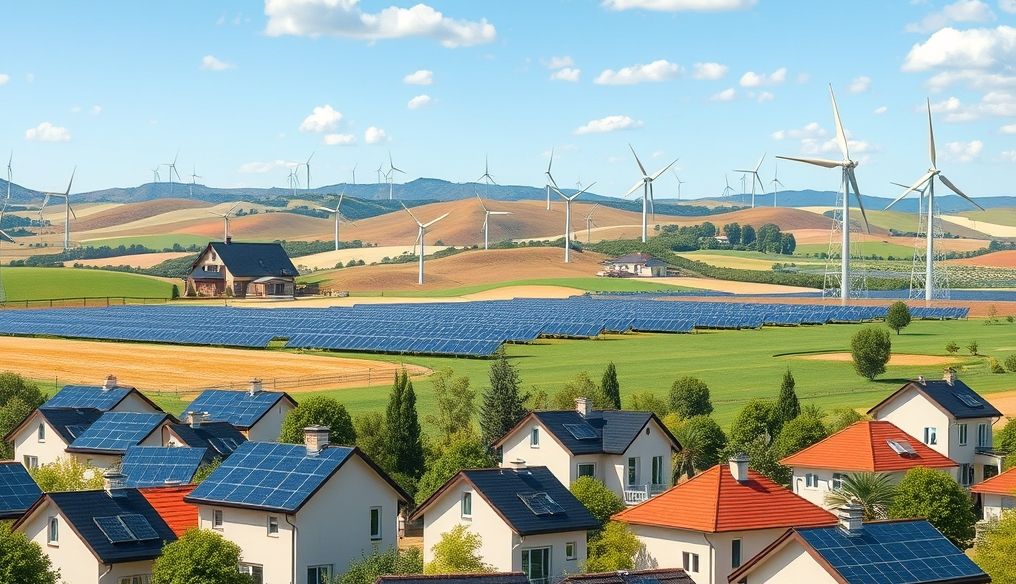What is Renewable Energy and Why is it Important?
Renewable energy is energy derived from natural sources that are constantly replenished, such as the sun, wind, water, and geothermal heat. Unlike fossil fuels (coal, oil, and gas), renewable energy sources are inexhaustible and do not contribute to greenhouse gas emissions that cause climate change.
Importance of Renewable Energy:
- Mitigating Climate Change: Reducing reliance on fossil fuels and decreasing carbon emissions.
- Improving Air Quality: Reducing pollution from burning fossil fuels.
- Creating Jobs: Generating new jobs in renewable energy sectors, manufacturing, installation, and maintenance.
- Enhancing Energy Security: Reducing dependence on foreign energy imports.
Solar Energy: Harnessing the Power of the Sun
Solar energy is the conversion of sunlight into electricity or heat. There are two main ways to harness solar energy:
1. Photovoltaic (PV) Cells
Photovoltaic cells are made of semiconducting materials (usually silicon) that convert sunlight directly into electricity. When light strikes the cell, photons cause electrons to be released, creating an electric current.
How PV Cells Work:
- Light Absorption: The cell absorbs sunlight.
- Electron Release: Photons cause electrons to be released from silicon atoms.
- Current Generation: The free electrons move through the cell, creating an electric current.
- Electricity Collection: The electric current is collected and directed to the electricity grid or used directly.
Uses of Solar PV Energy:
- Rooftop Solar Panels: To generate electricity for homes and businesses.
- Large Solar Farms: To generate electricity on a large scale to power cities and regions.
- Portable Devices: Such as solar phone chargers and calculators.
2. Concentrated Solar Power (CSP)
Concentrated solar power uses mirrors to focus sunlight onto a thermal receiver, which heats a fluid (such as oil or molten salt) to produce steam. The steam is then used to power a turbine to generate electricity.
How CSP Works:
- Sunlight Concentration: Mirrors are used to focus sunlight onto a receiver.
- Fluid Heating: The concentrated sunlight heats the fluid.
- Steam Production: The hot fluid is used to produce steam.
- Electricity Generation: The steam is used to power a turbine to generate electricity.
Uses of Concentrated Solar Power:
- CSP Power Plants: To generate electricity on a large scale.
- Heating and Cooling: To provide heating and cooling for buildings.
- Water Desalination: To provide clean drinking water.
Wind Energy: Leveraging the Power of the Wind
Wind energy is the conversion of the kinetic energy of the wind into electricity using wind turbines. When the wind blows on the turbine blades, they rotate, which in turn rotates a generator to produce electricity.
How Wind Turbines Work:
- Wind Rotates Blades: The wind blows on the turbine blades, causing them to rotate.
- Generator Rotation: The blades rotate the generator, which converts kinetic energy into electricity.
- Electricity Collection: The electricity is collected and directed to the electricity grid or used directly.
Types of Wind Turbines:
- Horizontal Axis Wind Turbines (HAWT): These are the most common, featuring blades that rotate around a horizontal axis.
- Vertical Axis Wind Turbines (VAWT): These feature blades that rotate around a vertical axis and are more suitable for urban areas.
Uses of Wind Energy:
- Wind Farms: Large groups of wind turbines to generate electricity on a large scale.
- Small Wind Turbines: To generate electricity for homes and small businesses.
- Water Pumping: To provide water for irrigation and other uses.
Challenges and Opportunities in Renewable Energy
Despite the numerous benefits of renewable energy, it faces some challenges:
- Intermittency: Solar and wind energy depend on weather conditions, meaning they are not always available.
- Cost: The initial cost of installing renewable energy systems can be high.
- Storage: Renewable energy needs effective storage solutions to ensure availability when needed.
Opportunities Available:
- Technology Development: Continuous advancements in renewable energy technology are improving efficiency and reducing costs.
- Government Support: Governments offer incentives and subsidies to encourage the use of renewable energy.
- Environmental Awareness: Awareness of the importance of renewable energy is increasing among consumers and businesses.
Renewable Energy Storage: Key to Sustainability
Due to the intermittency of renewable energy sources like solar and wind, energy storage plays a crucial role in ensuring a continuous and reliable supply of electricity. There are several ways to store renewable energy:
- Batteries: Batteries are used to store electricity generated from solar and wind power.
- Pumped Hydro Storage: Water is pumped to an elevated reservoir during periods of excess energy production, then released to generate electricity when needed.
- Hydrogen: Electricity generated from renewable energy can be used to produce hydrogen via electrolysis of water, then the hydrogen is stored and used later to generate electricity or as fuel.
The Role of Government Policies in Supporting Renewable Energy
Government policies play a critical role in promoting the development and deployment of renewable energy. These policies include:
- Tax Incentives: Governments offer tax incentives for companies and individuals who invest in renewable energy.
- Renewable Energy Standards: These standards require utilities to generate a certain percentage of their energy from renewable sources.
- Feed-in Tariffs: These tariffs guarantee renewable energy producers a fixed and guaranteed price for the electricity they produce.
The Future of Renewable Energy: Towards a Sustainable World
Renewable energy is the future of energy. As technology continues to evolve and costs decrease, renewable energy will become more competitive with fossil fuels. Renewable energy can play a crucial role in building a sustainable future for generations to come.
Statistics and Figures:
- In 2023, renewable energy accounted for approximately 30% of total global electricity production.
- The International Renewable Energy Agency (IRENA) projects that renewable energy will account for 85% of total global electricity production by 2050.
- China is currently investing more than any other country in renewable energy.
Practical Tips for Adopting Renewable Energy
There are many ways you can adopt renewable energy in your daily life:
- Install solar panels on your roof.
- Purchase electricity from a renewable energy provider.
- Use energy-efficient appliances.
- Reduce your overall energy consumption.
Renewable energy is not just an option, it is a necessity for building a sustainable and prosperous future.




